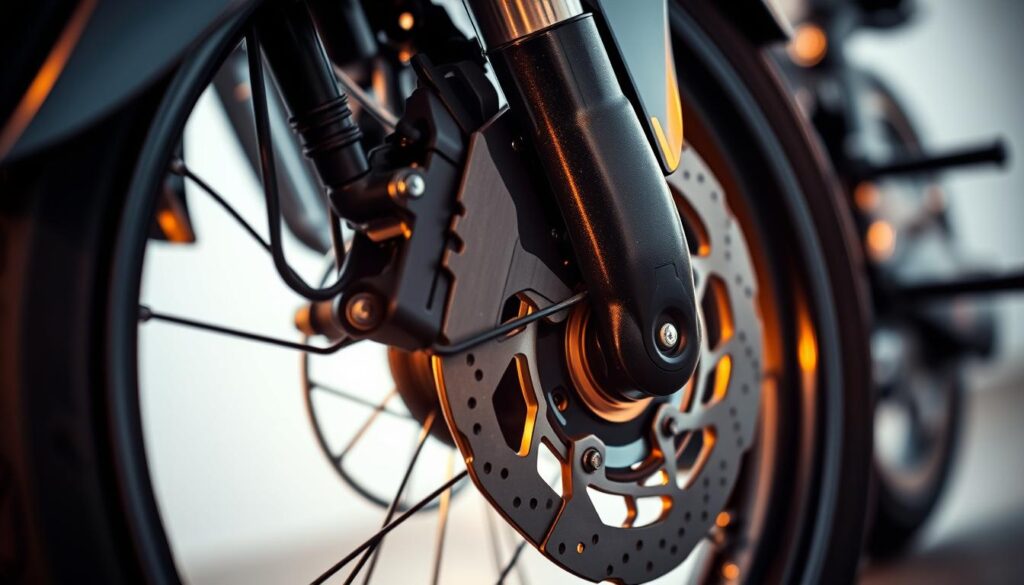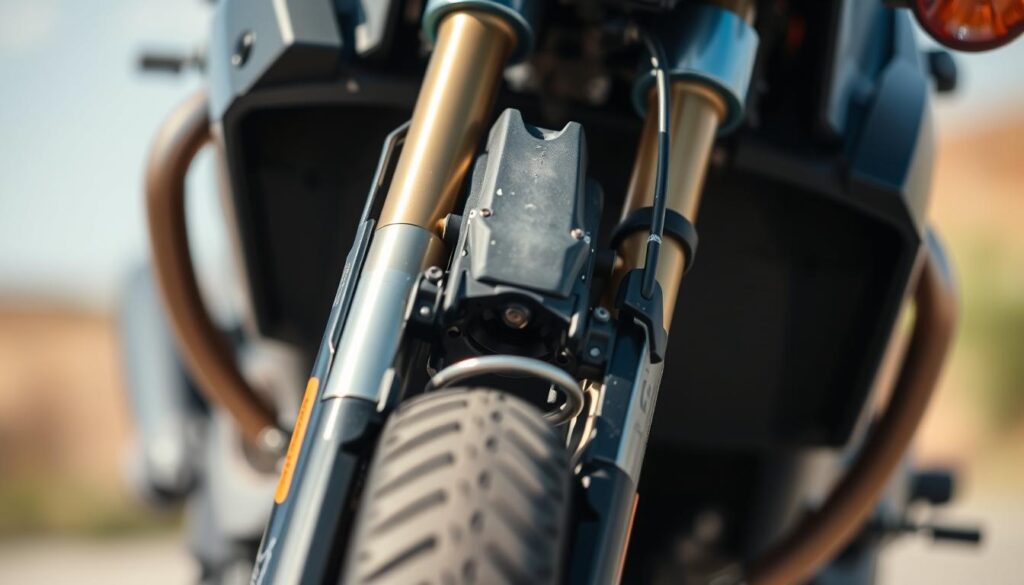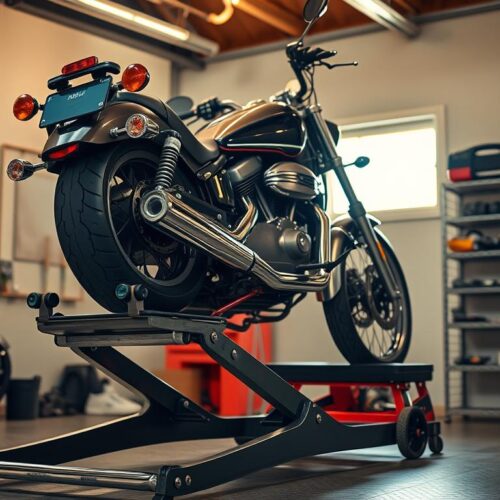Before you take off on your next trip, make sure to check your motorcycle carefully. Your safety and the bike’s reliability are super important. Following a detailed motorcycle checklist can help protect both. Keeping your bike in top shape boosts its performance and keeps it going longer. If you inspect important parts regularly, you’ll be more at ease on the road. Always put your pre-trip motorcycle checkup first. This way, every ride will be both safe and fun.
Why a Pre-Trip Motorcycle Checkup is Crucial
A pre-trip motorcycle check is a must to keep you safe on the road. Mechanical failures can lead to dangerous accidents or breakdowns. By checking your bike regularly, you can avoid these problems and have a safer ride. Ignoring essential maintenance can lead to high repair costs and could even put your life at risk.
Using a system like the POWDERS acronym makes it easier to remember critical checks. This method highlights the importance of inspecting:
- Petrol
- Oil
- Water
- Drive
- Electrics
- Rubber
- Security
Building good maintenance habits improves safety and boosts confidence, especially for new riders. Doing a detailed pre-trip bike check means a safer, more enjoyable ride. It gives you peace of mind while travelling.
Tire Condition and Maintenance
Your motorcycle’s tires are crucial because they touch the road. It’s essential to keep them in good shape for safe riding. Checking tire pressure, tread depth, and looking for damage is key. Before you ride, use a good gauge to check tire pressure against the manual’s advice.
Inspect the tread depth carefully. This is extra important when it rains because deep treads help remove water from the road. Be on the lookout for cracks or bulges, as these could mean the tire might fail. If you see any damage, get it fixed right away to prevent accidents.
Right tire pressure makes the bike handle better and can even save gas. Making sure your tires are in great shape is crucial when you prepare for a ride. A detailed tire check keeps your rides safe and fun.
Fluid Levels Check
Checking fluid levels is key for your bike to work well. It’s important to look at engine oil, brake fluid, coolant, and transmission fluid often. Each fluid has a vital role in making your motorcycle run smoothly.
Look at your bike’s manual to know the right levels and how to check them. If you see any leaks, act fast. Low fluids can cause big problems, like your engine getting too hot or brakes not working right.
Keeping up with fluid maintenance helps your motorcycle last longer and perform better. Here’s a chart with the main motorcycle fluids, what they do, and when to check them:
| Fluid Type | Purpose | Recommended Check Interval |
|---|---|---|
| Engine Oil | Lubricates moving parts for efficient operation | Every 1,000 miles or as per owner’s manual |
| Brake Fluid | Ensures responsive braking | Check every 6 months |
| Coolant | Prevents overheating | Check every 1,000 miles |
| Transmission Fluid | Facilitates smooth gear shifts | Every 4,000 to 5,000 miles |
Keeping an eye on fluid levels means safer and more fun rides on your bike.
Brake System Evaluation
The brake system is key to your motorcycle’s safety and good performance. First, check how worn your brake pads are. If the pads look thin, you should replace them quickly to keep your stopping power strong.
Then, look at the brake fluid levels. Not enough fluid can make your brakes work poorly, making it hard to stop. Fill it up with the fluid the bike maker suggests if it’s low. Also, listen for any strange sounds, like grinding or squeaking, when you use the brakes; these noises could mean there’s a problem.
Checking the brake lever and pedal for firmness is crucial before you ride. If they feel too soft, it might be a sign of air in the lines or a hydraulic issue. Make sure your brake lights work. It proves they’re working and makes you easier to see. Keeping your brakes in check means you can avoid risky situations and have a safer ride.

Lights and Signals Functionality
Having your motorcycle lights work right is key to being seen and safe while riding. Always check your lights before you go out, including low and high beam headlights. This ensures you can see well and others can see you too.
Turn signals and brake lights are also very important. They need to work fast and clearly. This is how you tell other drivers what you are doing. A signal that doesn’t work right could cause confusion and lead to an accident.
Don’t forget to check the horn and dashboard indicators too. They’re part of your bike’s electrical system, which needs to be in good shape. By checking these often, you make sure you’re seen and safe on the road.
Chain and Belt Maintenance
The motorcycle chain or belt is key in moving power to the wheels. Keeping this part in check is crucial for your bike’s performance. It’s important to regularly check the motorcycle chain for issues like slackness, rust, or wear.
After riding in the rain, it’s vital to lubricate the chain. This stops rust and keeps it working smoothly. Always check the sprockets for any signs of damage. If you find any, replace them quickly to keep everything running well. Stick to the guidelines from your bike’s maker for when to replace parts.
| Maintenance Task | Frequency | Purpose |
|---|---|---|
| Inspect chain tension | Every ride | Ensure efficient power transfer |
| Lubricate chain | After wet rides | Prevent rust and wear |
| Check sprockets | Monthly | Identify wear or bending |
| Replace chain/belt | Based on manufacturer guidelines | Maintain drivetrain efficiency |
Adding these tasks to your regular bike care will make it perform better and last longer. Paying attention to both chain and belt condition is key. It helps ensure a safe ride every time.
Battery Health Assessment
A well-functioning motorcycle battery is key for a smooth ride. Always start with a maintenance check on the battery terminals. Make sure they are not corroded. Tight and clean connections are important for electrical efficiency. They also help avoid troubles while driving.
Before a long trip, testing your battery is a smart move. It ensures your battery has the correct voltage. By doing this, you help your battery last longer and keep your motorcycle in good shape.
Keeping up with battery replacement is crucial. Putting off battery maintenance can hurt your motorcycle’s performance and safety. Simple checks shouldn’t be ignored. They can prevent avoidable issues.
Suspension and Chassis Inspection
Checking your motorcycle’s suspension and chassis is key for a safe ride. Suspension parts help keep your ride smooth and the bike stable. Begin by looking at the fork seals for oil leaks, which can mean you need new parts.
Then, adjust the compression and rebound settings to match how and where you ride. Hearing strange noises when the suspension moves is a warning sign. Watch out for any signs that you might need a pro to look at it.
Finally, check the chassis for any damage that could affect your ride. This thorough check ensures your motorcycle is in top shape. It makes your ride more comfortable and safe.

Helmets and Protective Gear Check
Checking your motorcycle gear is key to staying safe. Protective gear is a big part of staying safe on your ride. First, look over your helmet for cracks or damage. It should fit well and not be too tight. Also, make sure the visor is clear for good visibility in all lights.
Now, check your jackets, gloves, and boots. Each item must be in good shape and work well. Check for any damage that could lower their safety. Gear that absorbs impact well can offer extra protection in crashes.
Make a checklist to ensure you don’t miss anything. Here are the important items to look at:
| Item | Checkpoints | Notes |
|---|---|---|
| Helmet | Cracks, fit, visor clarity | Replace if damaged |
| Jacket | Tears, zippers, insulation | Ensure it offers impact resistance |
| Gloves | Wear on palms, fit, flexibility | Choose gloves with reinforced knuckles |
| Boots | Wear on soles, ankle support, waterproofing | Opt for boots with good grip |
Adding this check to your routine is smart for any rider. Taking time to check your gear can really pay off on the road.
Emergency and First Aid Kit Essentials
Every motorcycle rider needs to have a good emergency kit. It’s key for keeping you safe on your trips. Having the right supplies ready means you can handle any surprises that come your way while riding.
Here’s what you should pack:
- Adhesive bandages for minor cuts and scrapes
- Antiseptic wipes to clean wounds
- Gauze pads to manage larger injuries
- A flashlight to see in the dark
- Basic tools for fixing your bike on the spot
Get to know your emergency kit before you ride out. Check that everything is in order and easy to grab when needed. Being well-prepared not just gives you comfort, but also makes your ride safer.
Planning Your Route and Stops
Before you start your motorcycle trip, planning your route is key. This planning makes the trip smooth and fun. Note the rest stops along your way to stay alert and focused.
Use map apps or GPS to navigate. They provide up-to-date info to improve your trip. Always carry a paper map in case your tech fails. Know about any roadblocks or weather issues ahead.
When planning your trip, think about how long it will take and the roads you’ll use. Below, a table highlights important things to consider for your route:
| Consideration | Description |
|---|---|
| Time Estimates | Calculate total trip time including rest stops. |
| Fuel Availability | Identify gas stations along the route to avoid running out of fuel. |
| Scenic Routes | Explore winding roads or beautiful landscapes that enhance your journey. |
| Rest Stops | Schedule breaks for rest, food, and stretching during longer rides. |
| Safety Checks | Be aware of weather conditions and monitor for any travel advisories. |
Good planning and taking breaks make your motorcycle trip safer and less tiring. Set realistic goals for how far you ride each day. Following these tips will help prepare you for an adventurous road trip.
Final Safety Reminders Before Departure
Before you hit the road, go over your motorcycle safety tips one more time. Make sure you have checked everything on your list. This includes tire pressure and fluid levels. Doing this makes your trip safer and boosts your confidence.
It’s vital to make sure you’re ready, both mentally and physically. Check if you’re feeling alert and healthy. Being tired can greatly affect how well you ride, so be prepared. Also, think about the weather and road conditions you might face.
Remember your riding skills and the safety rules. A quick check before you leave can help. Always think about safety and stay aware of your environment. Make every trip fun and secure.




